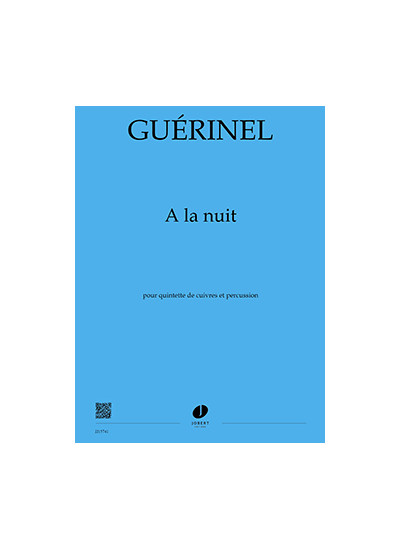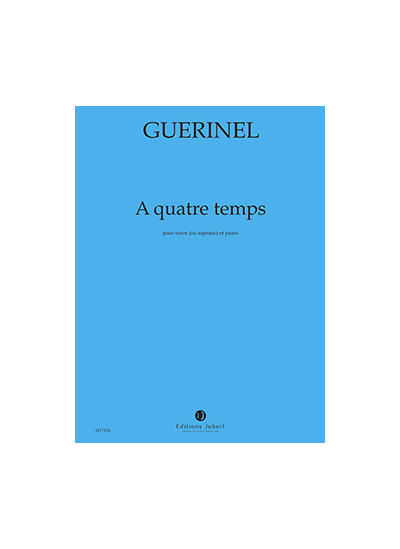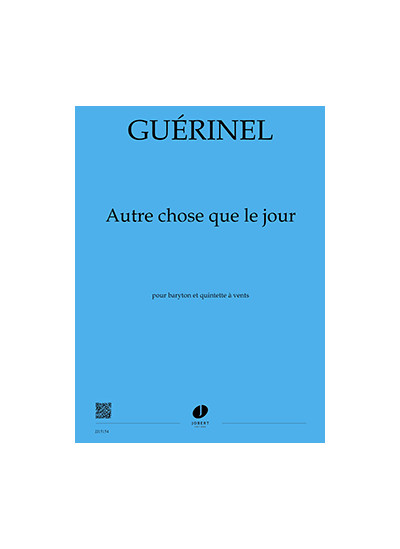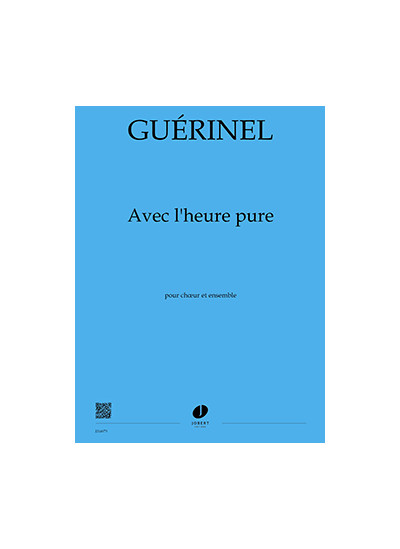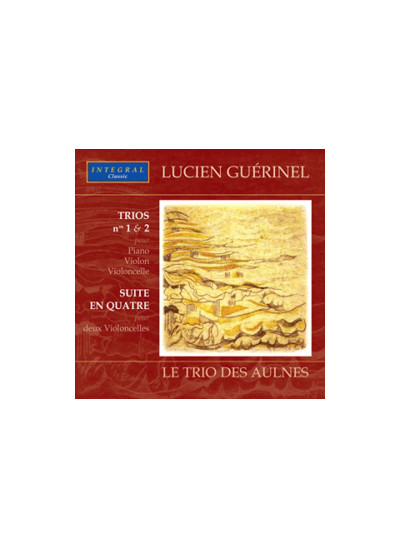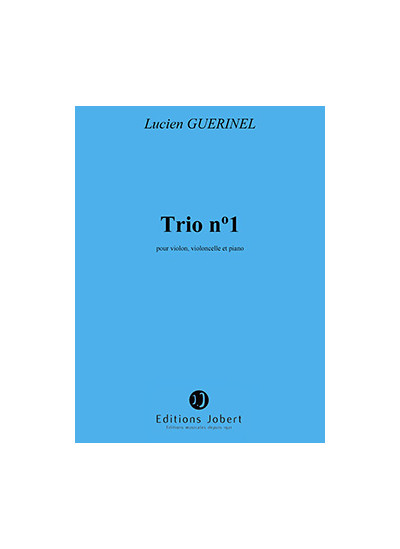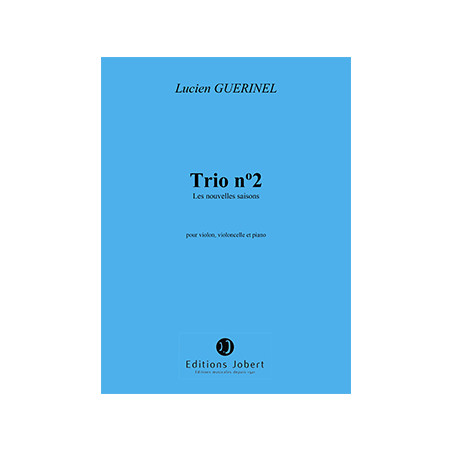
Man succeeds at this paradox of assuming the responsibility of global warming, all the while relentlessly giving it a cold shoulder. A new season, perhaps, transgressing the harmony of those that preside over nature, and that could go so far as to alter the alternation...
Musical power is rather slight before such an empire, but it could at least, in memory of all of the "Seasons" inventoried in artistic production, convey the irony and the bitterness implied by so many disastrous events.
9.11 - as related by Saint Bartholomew - is present in this trio. An extremely fragile chamber ensemble (oh! the cruelty of words) gives way before such tragedy, it is the gesture, discreet, that I aspire, and am devoted to.
Lucien Guérinel
Sub titled "Les Nouvelles Saisons" (New Seasons), within these pages there is an underlying idea linked to an event which sends our civilisation back to the hell which it created for itself: the attack of September 11 on the twin towers in New York.
How can one resist, if one is a creator, if it is only by testifying with ones art whatever the cost, and to continue practising it, whilst it is decried or rejected, ridiculed or ignored by the civilisations which transmit it and develop it. What Lucien Guérinel highlights here is the agony of our civilisazions and of course, the ways by which it is felt: intolerance, obscurantism, diktats of all kinds, indiscriminate violence, loss of values, contempt for life, etc.
1st Movement: "Un beau matin"
With the ferocious expression a long virtuoso phrase on the cello climbs to the top of a range with the help of the violin. It is a premonition of a forthcoming event, abrupt, unexpected and inescapable which is con?rmed by a dramatic suite of held chords on the piano.
These two elements which characterise the ?rst movement are stated at the very opening. They will continue to follow each other and be juxtaoosed, creating a sort of anguished mood which will only resolve itself at the end with held chords accompanied by an ostinaro on the piano, followed by remaining chords and four chromatic notes which fade before disappearing.
2nd Movement: "Bantering square"
Arpeggios wish dissonant chords, stretched scales with little chromatic clusters, trills, elongated intervals from the very lowest to the super high note, balancing semiquavers, major and minor seconds, harmonic sounds in the strings, that is the material exposed on this page full of biting irony.
One thinks, wrongly, of Eden (since lost) described by Ives in his piece entitled "Central Park in the dark", where the apparent calm hides the storm to come. It is perhaps the same 11th of September...
3rd Movement: "Voix perdues"
The theme on four chromatic notes (held within 2 minor third) opens out and then contracts between major seconds and minor seconds, above which the piano (in the right hand only) creates a few arpeggios around a G sharp which, initially at the top of the range soon falls to the lower.
And it is on this note which is repeated ?ve times like the toll of the bell that this movement ends. These "lost voices" are chose which, lost under the steel and concrete rubble, represent the pangs of death.
4th Movement: "Whispering and screams"
A beat on the piano, glissandi on pizzicato, descending chords (with the original major and minor seconds), two repeated bars of crotchets and then in semiquavers an articulated trill (in the strings) founded once again as always on a second (this time a minor second).
The piano accompanies with constant jumps in both hands (notice the impressive sevenths and ninths which are only extensions of the seconds already found several times in each of the movements).
5th Movement: "Requiem"There are few incidents in this short funeral piece... A brief introduction on the strings (as Introit): double-stopping on the violin and three different notes with each intervention of the cello which are deployed in an ambitus restricted to a ?fth where different ways of playing are used (from pizzicato to ponticello).
A long suite of chords follows (as Chorale), a funeral lamentation on the strings, the tolling of the piano, very high harmonics, descending chromatics (as in J.S. Bach when the curtain of the temple of Jerusalem is torn as Christ cruci?ed expires), and then silence. All is said in the shortest possible time. A concise vision of eternity.
6th Movement: "Feux croisés"
Two ascending and crescendo arpeggios on the piano end with chords. Thus begins this movement, which in two bars, collects the whole range of instruments present. The interupted arpeggios on the strings ?nish their path with two ascending leaps linking up with a hold none separated by a fourth.
This signal is tho beginning of a rhythmical pianissimo passage where each instrument weaves notes around a pedal note (the piano oscillates between a super high and a super low note) until two scintillating garlands on the piano emerge on a tremolo in the strings (still pianissimo) which follows a rhythmical unity ending with a glissando.
The "Feux croisés" are now launched: short rhythmical panting, repeated notes, broken or inverted arpeggios, rising and falling motifs occupying the entire spectrum of sound... all melodic ?gures are combined into various metamorphoses before the arrival of a short crescendo leading to an unexepected fortissimo, from where, on four occasions, will escape a held interval of an augmented fourth. Under the assault of a last ascending piece from the piano it ends in a quadruple forte in the sound of which becomes embedded a pianissimo on the cello followed by repeated super high harmonics on the violin as it dies away. Three bars of silence end this movement.
The articulated trill reaches the top in successive stages then is interrupted in order to better begin again another twice in the middle register. The elements of the beginning then return and slightly changed, take their place in a true mosaic (which serves as the development) into which is interwoven once again the articulated trill.
Two rings of a bell introduce a kind of stretto in which, over four bars, we ?nd again the glissandi followed, after a sharp fall, by tho superimposition of the principal elements (the trill, the arpeggios, the broken rhythm in semiquavers) to which is added the initial theme hammered out on the piano (the four chromatic notes are transposed).
The falling movement (in chords) moves from the piano to the strings to end with a pause to which are added two resonant chords at the very top range of the piano. Respiration. The piano picks up again the articulated trill (this time on four chromatic notes separated by more than two octaves) adding to it the irregular movement of a pendulum on which the strings add a last reminder of the jumps in seventh and ninths (separated here also by two octaves).
Then follow the last jumps by the piano (in progressive arpeggios upwards) accompanied by the opposing glissandi of the strings which in only two bars get rid of the articulated trill before concluding the movement, col legno, in nocturnal mood. The pictures suggested by this page as well as its title are suf?ciently explicit and need no explanations which by now are superfluous.
7th Movement: "Such stuff as dreams..."
These words are from the famous verse of Shakespeare "We are such stuff as dreams are made on". A dream being nothing more than a vision of the imaginary whilst awake, we will not be surprised by the brevity of this page which picks up the attributes of the preceding movements in order to weave, around a silence, a cameo of phantasmagorical sounds: a harmonic fourth in the strings (at the very top) which separates from the piano in the extreme low register, an abysm of nothingness (reminiscent of the abyss in Berlioz' Requiem?). This fourth always pianissimo becomes rhythmically animated before resolving itself in a minor ninth (which is an extension of... a minor second).
ls it possible to integrate horror with the reality of our conscious thought or is it nothing but a nightmarish dream?
8th Movement: "La fêlure"
lt is attaca, with a trill on the piano and a Beethoven-like motif on the strings, which starts this movement, so well characterised by its lines of song continually broken and repaired with stubbornness around a repairing rhythmic melody. The instruments here launch themselves towards the very high notes then fall, their momentum interrupted by trills on which they lean in order to start looking again for an improbable light. There are another two long trills in the low register of the piano which frame a melody which cannot ?x itself and which ends, with unison strings on a low G sharp (which we have already met).
The fourth (already heard previously) becomes ?rmly established, so who will now have the last word: the C sharp of the piano, free and repeated up to the silence which will ensure the transition into the last movement.
9th Movement: "Mässig langsam"
The title is a malicious look at Wagner and at his Tristan (who was a "bombshell" and one of the most famous to attack tonality!)
It begins on the piano with a shy ascending garland interrupted three times (the three rings of "destiny"?) when at last the strings enter, this page emphasises the G sharp which we have already met.
This concise movement which handles the ellipsis brilliantly places itself ironically in a world far removed from Wagnerian thinking. It ends with, in the strings, two superimposed fourths (one of which ended the previous movement)... Symbol of when you hold us! Yes, nothing will ever be the same again.
Alain Feron
Translated by Francis J. Anthony
Program Notes at Carnegie Hall (October 31st, 2016)


